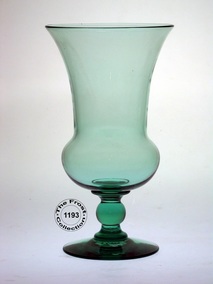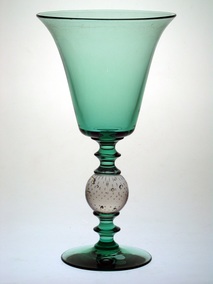| | Most of our Pairpoint friends are already aware that the era of the original Pairpoint manufacturing activities ended in 1938, and after many months of uncertainty, was revived as the Gundersen Glass Works in 1939. Fortunately for them, and us, they were not out of the marketplace long enough to lose their client-base; many of the premier jewelry stores, distributors, and retailers returned to do business. When Gundersen emerged from the Pairpoint Corporation collapse, they were much smaller in size, but they were able to re-employee many of the skilled workers, especially the highly-skilled ones, such as Anders Thoen and Gilly Gulbransen. As the manufacturing volume returned, the products retained the expected Pairpoint quality, which didn’t go into serious decline until the end of the Gundersen-era in the early 1950s. This single fact was likely the reason for the retention of the elite clientele. According to various sources, most notably “Mt. Washington & Pairpoint Glass, Volume Two,” by Kenneth Wilson and Jane Shadel Spillman , one of the quality distributors returning was Carbone, Inc., purveyors of quality general line goods. Not wanting to share the sources of their merchandise, their advertising references were limited to saying that their “Bedford Glass” line of decorative glass was made in the same factory as Pairpoint Glass. In one of their 1940 Christmas catalogs, they were promoting a new glass product line named Claire-de-lune, a blue-green hue made of Lime Glass. From our observations, many of the shapes offered by Carbone for the 1940 Christmas season were traditional Pairpoint shapes, but did include some more-contemporary-to-the-time items. To many Pairpoint collectors, the existence of the Carbone Claire-de-lune blue-green product line creates an anomaly. While looking in every way identical to Pairpoint items from decades previously, the color becomes a head-scratcher. Not only does the color confuse, but so does the dull “thunk” when tapped (because of the lime formula, not lead), and the fire-polished rough pontil mark. These items will appear infrequently, often at very low prices. They are worth acquiring, because they are, for all intents and purposes, true to Pairpoint’s craftsmanship; they’re just made under the Bedford Glass name by the old Pairpoint workers. Wonderful glass items were made during the 13-year Gundersen era. With a smaller staff, it’s my speculation that much of the superb quality of workmanship is due to the likelihood that a higher percentage of the items made came from the hands of the “stars” of the Pairpoint era, as the less-qualified workers and apprentices moved to other industries and the war effort. I know that engraver Carl Silva left to work for Morse Twist Drill. Hopefully this article sheds some new light on what has always been an unresolved curiosity for many Pairpoint collectors. Marion Frost 2015.09.25 |
|
0 Comments
Leave a Reply. |
Thank you for visiting our News Page. This page will be constantly changing and will feature all types of information and matters of interest. Please visit us often as we showcase Pairpoint products, people of interest, dealers, glass museums, and topics that would normally never see the light of day. And, let us know if there is a topic that you would like explained or discussed in future posting.
Categories
All
Archives
June 2022
Categories |





 RSS Feed
RSS Feed